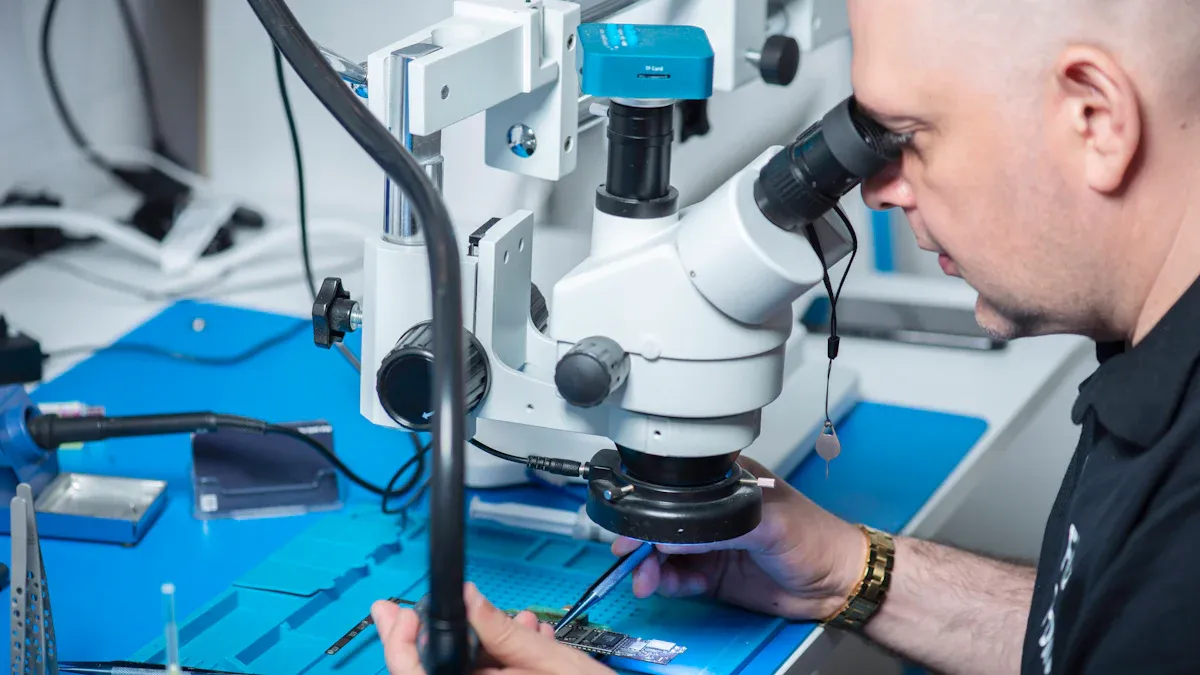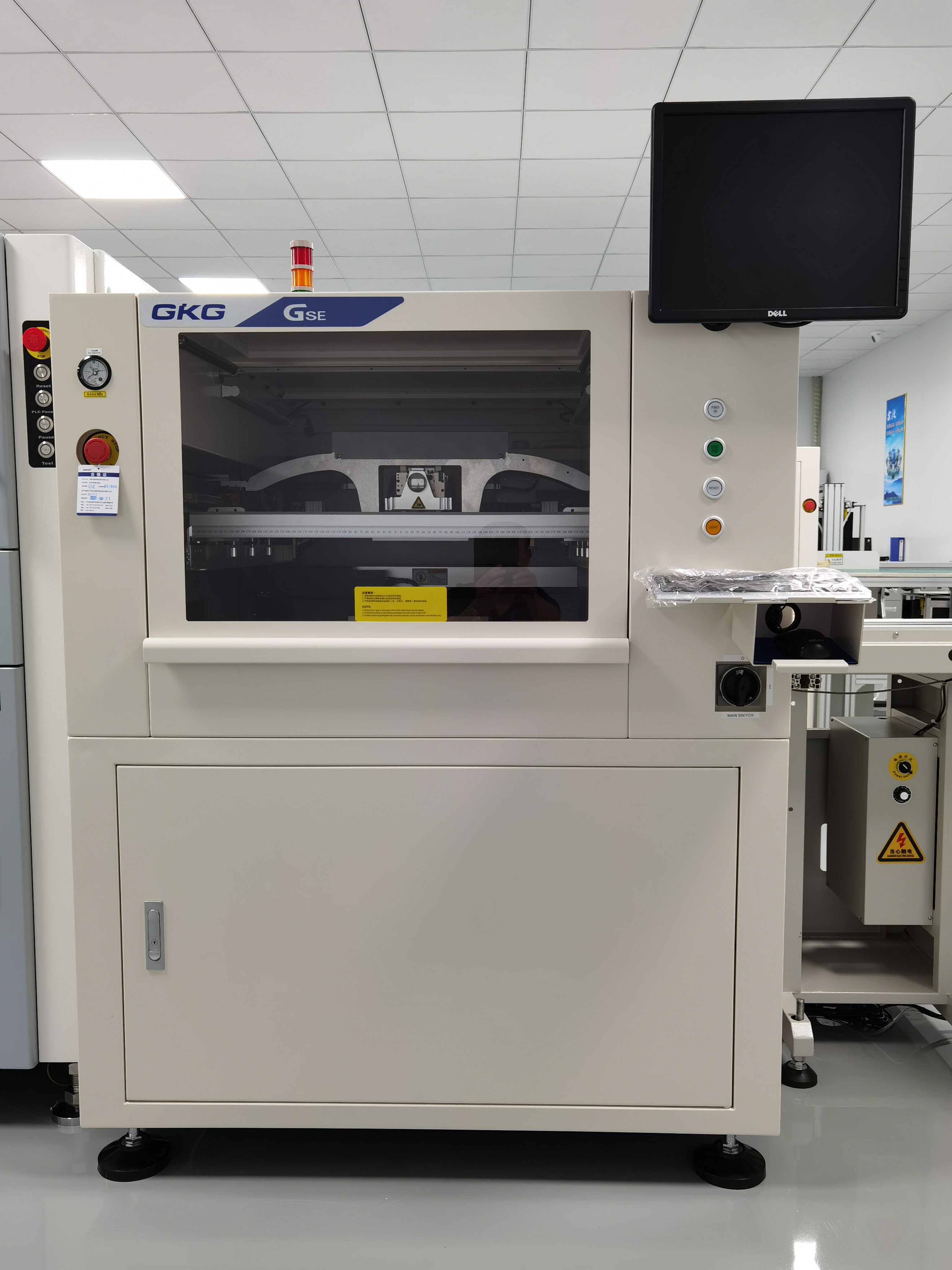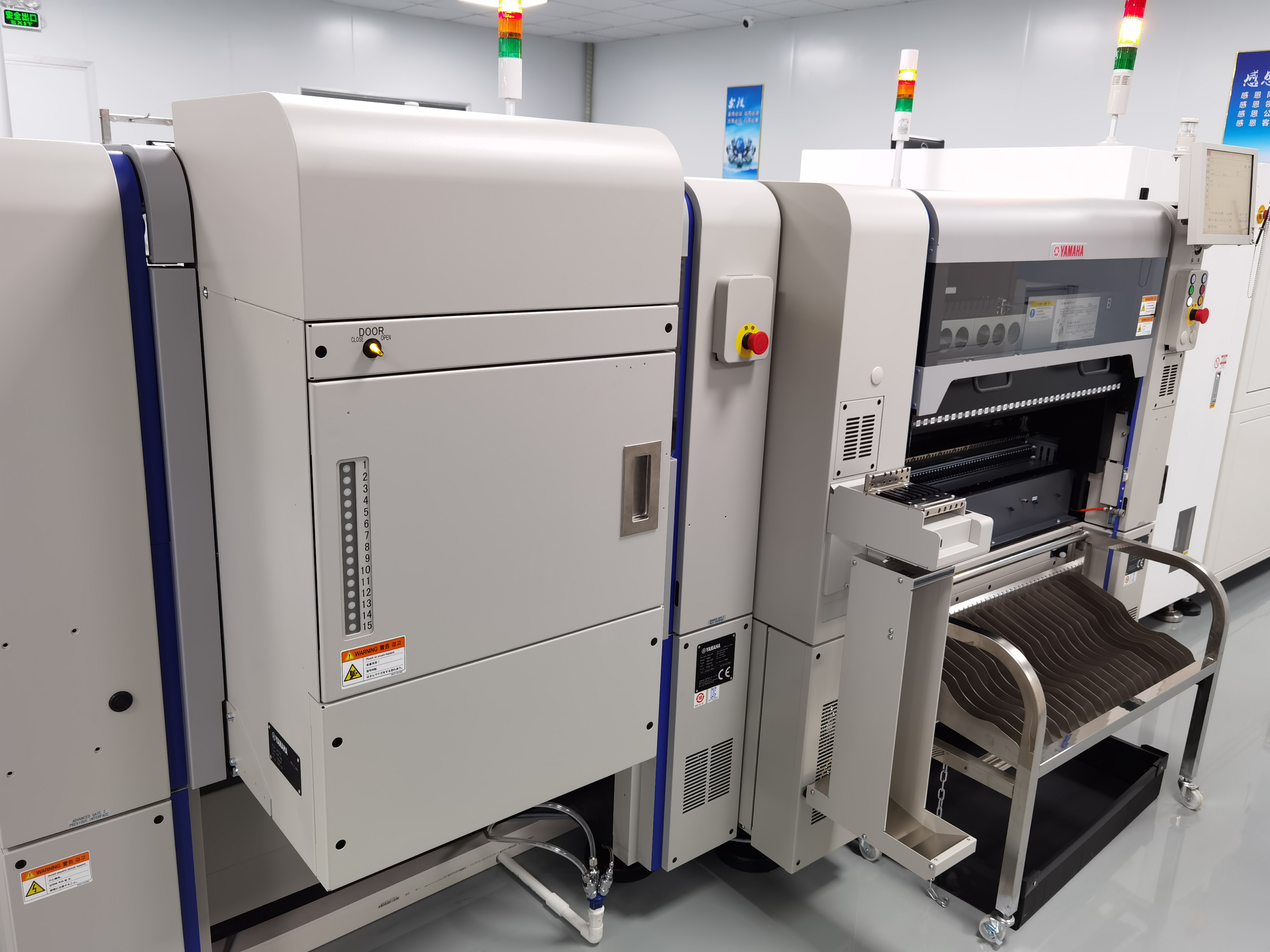7 Steps to Master Quality Control in Professional PCBA Manufacturing

Mastering quality control in PCBA manufacturing needs careful work.
Statistical Process Control and real-time data analytics help find changes in the process and lower mistakes.
Automated Optical Inspection and quality control checkpoints at each step make sure products follow tough rules.
Using these checkpoints all the time gives you dependable assemblies.
Key Takeaways
Careful quality control at each step, from design checks to final tests, stops mistakes and makes sure PCBA assemblies are strong and work well. - Using smart tools like AI inspections, X-ray scans, and automatic optical checks helps spot problems early. This saves time and money. - Regular testing and strict rules help people trust the product, make it better, and keep customers happy with good PCBA products.
Design Review
DFM and DFA
LTPCBA uses DFM and DFA to make sure designs are easy to build. The team follows ISO, IATF, and UL rules so each pcb assembly meets high standards. A good design review is the first step in quality control for pcba. This step stops mistakes before they happen in the factory.
Engineers at LTPCBA use top methods and rules to check every pcb. They look at safety, how well it works, and if it can be made easily. The process has these steps:
Using IPC-2221 and IPC-7351 rules for printed circuit boards.
Checking schematic designs for part numbers, footprints, and electrical data.
Making sure parts are placed for easy pcb assembly and good panelization.
Looking at layout for controlled impedance, power, and less EMI.
Adding thermal management with reliefs, vias, and copper pours.
Using EMC/EMI ideas like grounding and shielding.
Doing design rule and electrical rule checks before making the board.
Checking the Bill of Materials and Gerber files to get ready.
Having team reviews to make sure everything matches and is correct.
These steps help LTPCBA make strong pcb assembly and lower pcba problems.
Documentation Check
A full documentation check is very important in pcb assembly. Many problems start when data is missing or wrong in the documents. LTPCBA checks all steps, test instructions, and data before making the pcb. This early check stops mistakes from spreading in the factory.
When the team checks documents, they look for missed steps, wrong sizes, or missing data. This check saves time and materials by finding problems early. It also keeps the whole pcb assembly process running well. LTPCBA updates documents with new lessons to stop old mistakes. Good documents help keep improving and make high-quality pcba.
Tip: Always pick a pcb assembly maker who checks documents well. This helps you get the best printed circuit boards.
Material Inspection

Component Verification
LTPCBA starts with strict checks for every pcb assembly. The team looks at all parts before they go to the production line. They only use parts from trusted suppliers. This helps stop missing parts and other mistakes.
Component verification uses smart machines. Machine vision and AI tools check each part for size and value. These tools also check where each part goes. They find errors like wrong or missing parts before work starts. LTPCBA uses pick-and-place machines to lower human mistakes. The process has these steps:
Error-proofing (Poka-Yoke) stops defects during pcb assembly.
Design for Manufacturability (DFM) makes pcb designs easier and uses standard parts.
Real-time inspection with machine vision finds defects early.
In-process inspection uses AOI and X-ray for deeper checks.
Metric | Value |
|---|---|
Accuracy Rate | |
Reduction in Defect Rates | 30% |
Inspection Time | Cut from 1 minute to 2.2 seconds per unit |
Cost Savings | 30 times less cost than manual inspection |
Return on Investment (ROI) | Less than two years to get money back |
These results show LTPCBA’s checks make pcb assembly better and save money.
Preventing PCBA Manufacturing Defects
LTPCBA’s checks stop pcba manufacturing defects early. The team checks each batch of parts for quality and if they are real. They look for damage, wrong labels, or fake parts. This careful work stops common mistakes before they reach the pcb line.
The team uses both people and machines to check parts. They match each part to the Bill of Materials and drawings. This makes sure every pcb assembly uses the right parts. By finding problems early, LTPCBA keeps pcba manufacturing defects low and gives good pcb products.
Note: Good checks help stop defects and keep pcb assembly lines working well.
Solder Paste Inspection
Process Control
LTPCBA uses special 3D SPI machines for solder paste. These machines check the height, volume, and area of the paste. They can measure very small amounts, down to 2 microns. The team watches these numbers to make sure each pcba is good. Process control starts with lining up the stencil the right way. The holes in the stencil must be the right size. Workers check the metal-to-flux ratio in the solder paste. This stops the paste from spreading too much and keeps it the same every time. The room must stay clean and dry. This keeps the solder paste safe from water and dirt. It helps stop problems during making.
The table below shows important things to check for solder paste:
Metric | Description | Significance to Quality Control |
|---|---|---|
Solder Paste Volume | Amount of paste on each pad (cubic micrometers) | Prevents weak joints or bridging |
Solder Paste Height | Thickness of paste deposit (micrometers) | Ensures strong bonds and even solder |
Solder Paste Area | Pad surface covered by paste (%) | Detects poor coverage |
Solder Paste Alignment | Offset of paste placement (micrometers) | Avoids misplacement and defects |
Keeping these numbers in the right range helps every pcba pass the checks.
Quality Control Checkpoints
LTPCBA puts many quality control checkpoints in the solder paste process. Automated SPI systems find problems like not enough solder, too much solder, or paste in the wrong place. These checks catch mistakes early and help save materials. Workers do tests like tapping and dropping to make sure the assembly is strong. Automated optical inspection checks again after solder paste and after reflow. This makes sure the quality stays the same.
Quality control also means cleaning the stencil often and checking it. This stops the holes from getting blocked and keeps the paste even. Testing at every checkpoint helps the team get better and keeps mistakes low. AI and machine learning in SPI systems help find problems faster and more exactly. These checks help LTPCBA make strong pcba assemblies that meet top standards.
Tip: Testing and checking at every step makes products better and keeps customers happy.
AOI and Visual Checks
Detecting Defects
Automated Optical Inspection, or AOI, is very important for LTPCBA’s quality control. AOI uses special cameras and AI to look at each pcba. It checks for missing parts, wrong placement, bad soldering, and surface problems. AOI can find even tiny defects. Its accuracy can reach 97%. AOI makes checking much faster. It can take only a few minutes instead of an hour. This helps find problems early in big pcba batches.
Manual visual inspection is also used. Skilled workers look at spots that machines might miss. They check for odd markings or small changes on the surface. Studies show that visual checks alone can miss small or tricky defects. But when AOI and visual checks are used together, the process is much better. Using both helps LTPCBA find problems early. This saves time and cuts down on expensive fixes.
AOI finds many problems like bad solder joints, wrong part placement, and surface flaws.
Finding problems early saves money and keeps defects away from customers.
AOI gives data that helps engineers fix and stop problems from happening again.
LTPCBA Quality
LTPCBA always aims for high quality in every pcba. The company uses AOI, visual checks, and strong testing at every step. Experts with lots of experience watch over the work. They make sure all parts meet tough rules. LTPCBA tracks things like First Pass Yield and waste to get better and more reliable. The company follows world quality rules like ISO and UL. All steps are done in-house.
The team checks layouts, cleans parts, and tests carefully. Regular checks at many points make sure each pcba is good for customers. LTPCBA’s focus on quality means customers get strong and high-performing products every time.
X-ray Inspection

Hidden Defects
LTPCBA uses X-ray inspection to find hidden problems. Visual checks cannot see these issues. X-ray can spot tiny voids in solder joints, as small as 25 microns. This meets IPC-A-610 standards. The system also finds parts that are not lined up, even if off by 50 microns. It can see if solder covers less than 75% of the area. These features help the team catch problems early and keep pcba quality high.
X-ray finds voids, cracks, and open spots inside solder joints.
3D X-ray CT scanning finds 30% more defects than 2D imaging.
AI-powered systems cut false alarms by 50% and boost accuracy by 25%.
A case study showed rework costs dropped by 40%. First-pass yield went up by 15% after using advanced X-ray inspection.
This technology helps LTPCBA stop costly recalls. It makes sure each pcba meets strict industry rules.
BGA and Complex PCBA
Ball Grid Array (BGA) and complex pcba need special checks. X-ray inspection gives a clear 3D view under BGA parts. This method finds solder bridges, air gaps, and cold joints that can cause failures. Early X-ray checks find bad units before they move on.
X-ray can find solder voids, opens, shorts, bridges, and misalignment.
2D X-ray gives a top view for bridges and voids.
3D X-ray lets the team check from many angles. This is important for tricky defects like head-in-pillow.
X-ray inspection does not harm the pcba, so more tests can be done later.
LTPCBA’s use of X-ray inspection makes sure pcba assemblies are strong and work well for tough jobs.
Electrical Testing
In-Circuit Testing
LTPCBA uses in-circuit testing to check each pcba for problems. This test looks for shorts, opens, and wrong values. The team uses a bed-of-nails fixture to touch many spots at once. This helps them find faults fast and keep quality high. In-circuit testing is good for big batches because it is quick and accurate. The results go into Statistical Process Control systems. These systems watch defect rates and help the team get better over time. When used with automated optical inspection, in-circuit testing helps more boards pass the first time and lowers rework costs. This way, LTPCBA gives customers reliable pcba assemblies.
Functional Quality Control
Functional testing checks if each pcba works like it should. LTPCBA uses this test to make sure every board meets its design goals. The team acts out how the pcba will work in the real product. They measure things like electrical continuity, solder joint strength, and where parts are placed. This step finds hidden problems that other tests might not see. LTPCBA also does environmental testing to see how the pcba handles heat, cold, and moisture. These tests give important numbers:
Solder joint strength and placement accuracy
Electrical continuity and how well it handles the environment
Functional testing makes sure each pcba is ready to use. By using these pcb assembly testing methods, LTPCBA keeps quality very high. The team tests at every step so customers get strong and reliable products every time.
Final QA and Packaging
Quality Assurance
LTPCBA always checks quality at the end of making each pcb assembly. The team does many final checks to make sure every pcb is good. They use Functional Testing and Burn-in Testing to see if the circuit works well and lasts a long time. High-voltage, insulation, and EMI tests help find hidden problems. Before packing, they do both visual and working checks. These steps make sure each pcba fits what customers want and follows the rules.
The team uses digital tools to watch each pcb from start to finish. This helps them find and fix problems fast. AI-powered Automated Optical Inspection looks for mistakes like solder bridges or parts in the wrong place. Digital twin simulations help spot risks before they reach the customer. Smart warehousing and delivery systems keep mistakes low and help ship on time. LTPCBA’s way makes sure each pcb assembly is ready to use when it leaves the factory.
LTPCBA’s last quality checks help customers feel safe and give strong support.
LTPCBA Standards
LTPCBA follows the best industry rules for every pcb assembly. The company meets IPC-A-610 and ISO 9001 rules. They also have UL and IATF certificates. The team tracks First Pass Yield and defect rates to keep quality high. They use in-line AOI and X-ray checks for every pcb. The table below shows important rules and results:
Category | Details |
|---|---|
Quality Standards | IPC Class 3, ISO 9001, UL, IPC-A-610 |
Delivery Timelines | 95% on-time SLA, 97% on-time delivery rate |
Quality Metrics | 99.5% first-pass yield, <100 DPMO defect rate |
Advanced Technologies | AI-driven control, in-line AOI/X-ray |
LTPCBA’s focus on tracking, strong rules, and customer help makes sure every pcba is the best it can be. The company’s packing keeps each pcb assembly safe during shipping and keeps customers happy with good support at every step.
Doing all seven quality control steps helps make sure PCBA assemblies work well and have no defects. Teams that check and use these steps get better results and happier customers. Using these methods all the time gives strong results. Focusing on quality control at each step builds trust and helps the company succeed for a long time.
FAQ
What makes LTPCBA’s quality control process unique?
LTPCBA uses special inspection tools and follows strict rules. The team checks each step to make sure every PCBA is high quality.
How does LTPCBA prevent PCBA manufacturing defects?
The team checks all materials and uses machines to help. They follow careful steps. Finding and fixing problems early keeps defects low and makes products work better.
Why is X-ray inspection important in PCBA manufacturing?
X-ray inspection finds hidden problems in solder joints and tricky parts. This helps each assembly meet rules and work well.
See Also
Complete PCBA Solutions From Production Through Final Testing
Seven Essential Quality Checks For Through Hole PCB Assembly
Important Methods To Enhance PCBA Durability Over Time
Comprehensive PCBA Manufacturing Process Guide For All Skill Levels
Ways Modern Turnkey PCBA Plants Guarantee High Quality Output
